|
|
 Ghosts
of the Past 3
Ghosts
of the Past 3

|
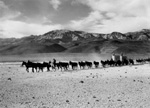
20 Mule
Team in Panamint Valley
(Frasers Foto Card) |
The
20 mule team (pictured left) driven by Russ Spainhower left Lone
Pine with Bruce Morgan's [see Mt. Whitney Pack Trains history]
Group of '49ers, November 23, 1949 in a treck across Panamint
Valley to Death Valley for the December 2nd Centennial.
These big wagons with wheels that weigh over eight hundred pounds
each, pulled by ten pair of mules driven with only a single "jerk
line", traveled at a speed averaging two miles an hour and
required ten days to make the trip from Lone Pine to Furnace
Creek Ranch in Death Valley. |

Bruce Morgan
at Lone Pine Lake
(Union Pacific Railroad Photo) |
For
more information about Bruce Morgan see Mt. Whitney Pack Trains history |

|
20 Mule Team
rigging photos courtesy of Paul Lamos from the archives of his
stepfather, and former MWPT packer, - Bill Smart. |
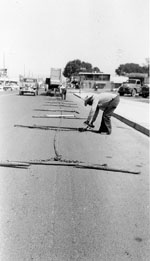
Bruce Morgan
laying out the 20 mule team rigging on U.S. 395 in Lone Pine. |
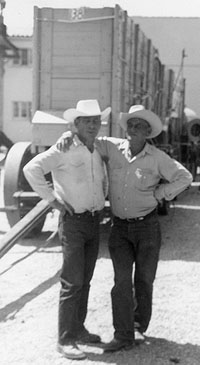
L to R: Vasie
Cline, Billy Bishop, Leppy Diaz, Leakey Olivas
(see enlarged photo for view of all) |
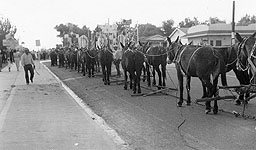
Checking out
the 20 mule team rigging before leaving Lone Pine |
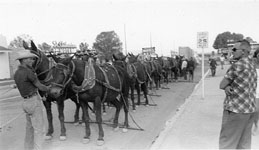
Checking out
the rigging on the lead mules. |
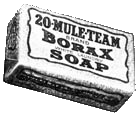 |
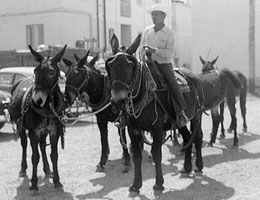
Billy Bishop
(who packed for Mt. Whitney Pack Trains for many years during
the 1950s) waiting to place the mules in their position in the
20 mule team. |
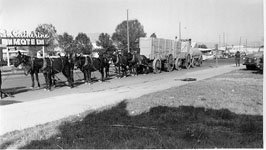
Hitched up and
ready to leave Lone Pine for Furnace Creek. |
The Mule |
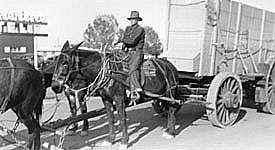
Vasie Cline
riding 'Ike' the mule.
Vasie was always the driver of the 20 mule team. |

20-mule
team all hitched up and ready to go. |
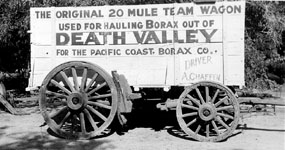
20 Mule
Team Wagon |
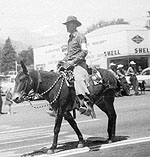
Bill Smart
riding 'Sam-ule' |
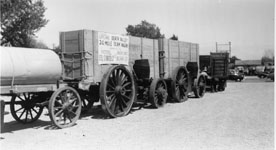
20 Mule
Team Wagons |
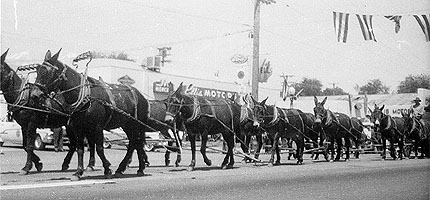
20 Mule
Team in Lone Pine |
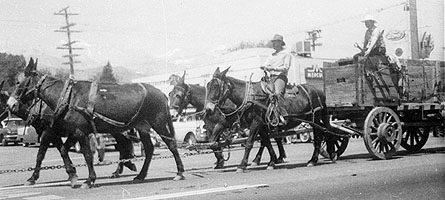
20 Mule
Team in Lone Pine |
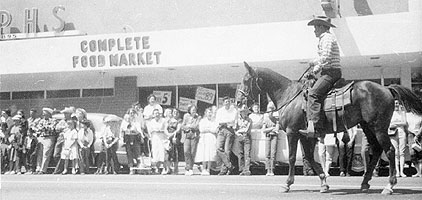
Tommy Jefferson
taking the lead out. |
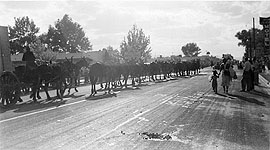
20 Mule
Team in Lone Pine |

The 20-Mule-Team & Borax Bill
by The Pacific Coast Borax Co.

 20
Mule Team Days
20
Mule Team Days
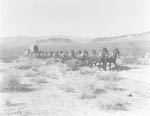
(Desert Magazine
photo) |

20 Mule
Team |
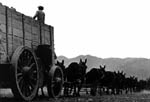
20 Mule
Team
(1954 National Geographic Photo) |
 This
is the true meaning of the term "team track." A [20
mule] team was literally drawn up beside a train for lading or
unloading. Here a load of 24 tons of nearly pure borax is being
loaded onto the AT&S. This
is the true meaning of the term "team track." A [20
mule] team was literally drawn up beside a train for lading or
unloading. Here a load of 24 tons of nearly pure borax is being
loaded onto the AT&S.
George Schreyer |

Borax Bill |
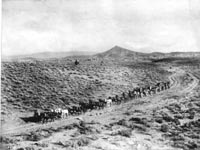
20 Mule
Team rounding a desert curve
(C.C. Pierce photo) |
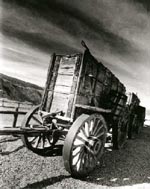
20 Mule
Team Wagon |

20 Mule Team
- (Pacific Coast Borax Co. photo) |

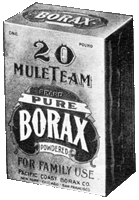 |
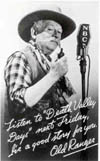
Death Valley
Days - "Old Ranger" |
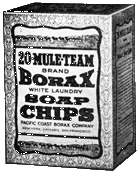 |
Commanding
the 20 Mule Team
Fourteen, 16, 18 mules, plus 2 horses, supplied the draypower.
The front span of mules were the "leaders"; the 2 horses
next to the wagon, and hitched to the tongue, were the "wheelers."
Twenty was the usual total, and 20 were needed on the steep incline
of Windy Gap, heaving some thirty tons of dead weight, including
the borax, the water cart, the unwieldy wagons themselves, and
a vast assortment of tools, food supplies and cooking equipment
attached to the sides. Altogether the outfit, in action, looked
like a cross between a circus wagon and a Connecticut peddler's
cart. Not since the construction of the Pyramids of Egypt had
such an impressive rig crossed a desert.
Stretched
out on the road, the leaders were a long 120 feet from the skinner,
who rode the nigh wheeler or sat enthroned high on the front
of the fore wagon. For such an entourage reins were useless.
Instead, the skinner held a stout, cotton jerk line in one hand
and a whip with a 6-foot stock and 22-foot lash in the other.
The
single line was strung through rings in the harnesses of the
twenty nigh mules to the bit of the nigh leader. To make a left
turn, the skinner pulled steadily on the line. To make a right
turn, the line was given a series of short jerks; the jerks made
the leader instinctively throw up his head, which in turn pulled
a strap attached to the right side of the bit-a system as simple
as it was ingenious. The leader took its cues from the line;
the rest followed.
 Commanding
a twenty-mule borax wagon was something like sailing a full-rigged
schooner singlehanded, using an oar for a rudder. In managing
the team the line was a help; the whip that could flick a fly
from the ear of the fourth off mule without disturbing a hair
was a help; the brakes were useful; the swamper riding the trail
wagon and working its brake was occasionally credited with giving
some assistance; and the box full of rocks kept on the seat to
pelt perverse mules beyond the reach of the whip was indispensable.
But all these aids were of minimum value in controlling the team,
compared to the effectiveness of the skinner's tongue.
An
inspired tongue and flexible vocal organs were what kept the
animals on course and pulling together. The teamster's words
had all the sting of his whip. That badge of trade was held in
reserve as a threat and rarely applied, but from the moment a
skinner mounted his seat with a "Git ep, ye God-damned -
git ep," the flow of profane eloquence was unreserved. The
vocabulary, to be sure, was limited. Mule skinners kept it that
way on purpose, so they maintained, in order not to strain the
intelligence of the animals or the lean-witted assistant, the
swamper.
The
profusion of four-, five-, and six-letter words had aim, thrust
and cut of unmistakable meaning and nuance. Mules were sensitive
beasts, each with a name, and when that name was linked with
the bite of the driver's rebuke, ears perked up, a tail wilted,
a quiver of terror or embarrassment seemed to pass over the hide,
as though a lash had struck.
The
yarn about the skinner who was converted overnight by a transient
evangelist originated at Mojave. In fact, the gospel bearer was
so proud of his proselyte that he accompanied him to the wagon
next morning to see him off. With the preacher looking on from
below, the skinner swung up to his high seat, sober, constrained,
humbled.
There
he sat for a long moment, trying to summon the magic words that
normally set his team in motion. For the first time in his life
he was tongue tied, totally bereft of his powers of persuasion.
The evangelist had deprived him of the Biblical vocabulary and
all the mortifying vulgarisms his mules understood. When he finally
bellowed the command to "Get ep," without a single
allusion to the Almighty or the organs of sex, the mules stood
transfixed in their tracks, and reportedly all twenty turned
their heads in unison to stare in wonderment at the master. The
evangelist lost a good convert long before the wagons approached
Windy Gap.
No
question about it, the borax teamster felt compelled to lean
rather heavily on diabolic conjuring. He had to be an unyielding
tyrant, a wizard and an artist, in one. Yet despite the Satanic
invocation, accidents did occur on the road to Mojave. Miscalculation
of a hairbreadth in rounding one of the turns in Windy Gap, the
failure of a leader to respond to a yank of the jerk line at
a moment of urgency, or the tripping of a pointer in leaping
the haul chain, could bring disaster. Everything depended on
everything else, and a minor slip-up could send the whole outfit
into a cliff or over the edge of one.
Commanding
a twenty-mule borax wagon was something like sailing a full-rigged
schooner singlehanded, using an oar for a rudder. In managing
the team the line was a help; the whip that could flick a fly
from the ear of the fourth off mule without disturbing a hair
was a help; the brakes were useful; the swamper riding the trail
wagon and working its brake was occasionally credited with giving
some assistance; and the box full of rocks kept on the seat to
pelt perverse mules beyond the reach of the whip was indispensable.
But all these aids were of minimum value in controlling the team,
compared to the effectiveness of the skinner's tongue.
An
inspired tongue and flexible vocal organs were what kept the
animals on course and pulling together. The teamster's words
had all the sting of his whip. That badge of trade was held in
reserve as a threat and rarely applied, but from the moment a
skinner mounted his seat with a "Git ep, ye God-damned -
git ep," the flow of profane eloquence was unreserved. The
vocabulary, to be sure, was limited. Mule skinners kept it that
way on purpose, so they maintained, in order not to strain the
intelligence of the animals or the lean-witted assistant, the
swamper.
The
profusion of four-, five-, and six-letter words had aim, thrust
and cut of unmistakable meaning and nuance. Mules were sensitive
beasts, each with a name, and when that name was linked with
the bite of the driver's rebuke, ears perked up, a tail wilted,
a quiver of terror or embarrassment seemed to pass over the hide,
as though a lash had struck.
The
yarn about the skinner who was converted overnight by a transient
evangelist originated at Mojave. In fact, the gospel bearer was
so proud of his proselyte that he accompanied him to the wagon
next morning to see him off. With the preacher looking on from
below, the skinner swung up to his high seat, sober, constrained,
humbled.
There
he sat for a long moment, trying to summon the magic words that
normally set his team in motion. For the first time in his life
he was tongue tied, totally bereft of his powers of persuasion.
The evangelist had deprived him of the Biblical vocabulary and
all the mortifying vulgarisms his mules understood. When he finally
bellowed the command to "Get ep," without a single
allusion to the Almighty or the organs of sex, the mules stood
transfixed in their tracks, and reportedly all twenty turned
their heads in unison to stare in wonderment at the master. The
evangelist lost a good convert long before the wagons approached
Windy Gap.
No
question about it, the borax teamster felt compelled to lean
rather heavily on diabolic conjuring. He had to be an unyielding
tyrant, a wizard and an artist, in one. Yet despite the Satanic
invocation, accidents did occur on the road to Mojave. Miscalculation
of a hairbreadth in rounding one of the turns in Windy Gap, the
failure of a leader to respond to a yank of the jerk line at
a moment of urgency, or the tripping of a pointer in leaping
the haul chain, could bring disaster. Everything depended on
everything else, and a minor slip-up could send the whole outfit
into a cliff or over the edge of one.
Excerpt from The Great California Deserts by W. Storrs
Lee
|



Floyd R. Evans 1949 photographs of the Death Valley '49ers Centennial
(Photographs courtesy of Rich McCutchan)
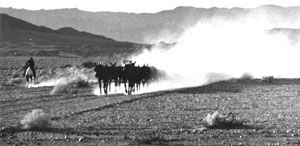
20 Mule
Team Centennial |
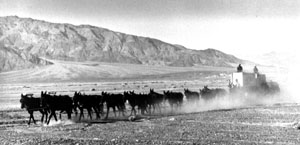
20 Mule
Team Centennial |
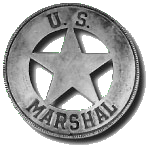 |
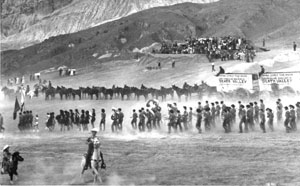
20 Mule
Team Centennial |
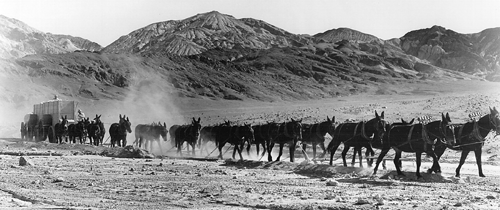
20 Mule Team
Centennial |

20
Mule Team and Western Links
 20
Mule Team Reading
20
Mule Team Reading


20 Mule Team Fotocard Courtesy of Bob Pilatos |
|

|